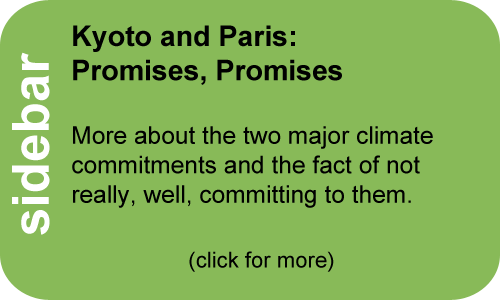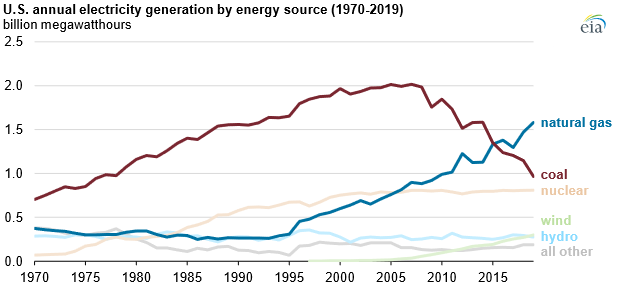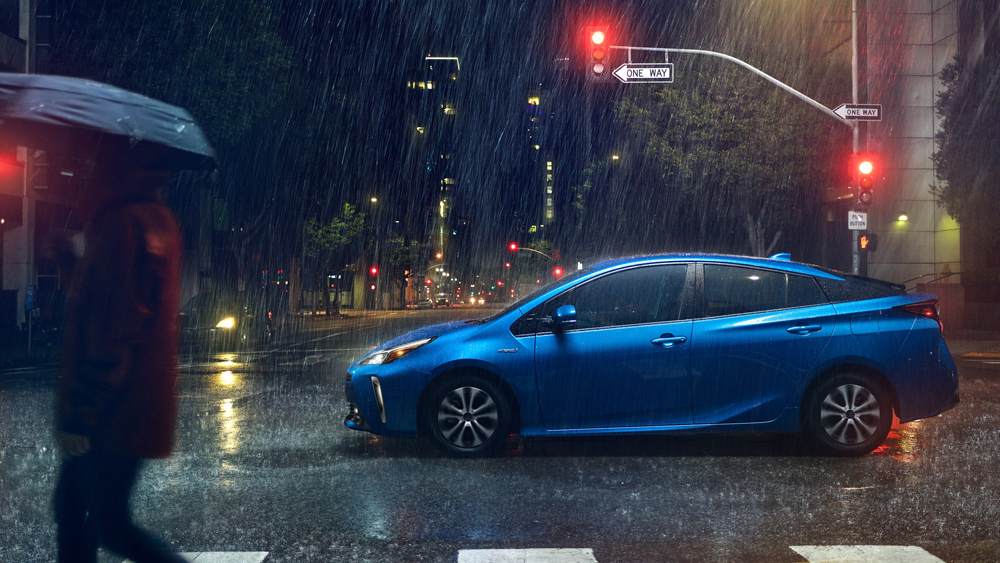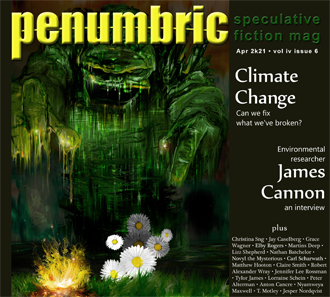
Omi Wilde's An Argument in a World of Wonders by toeken
TThe climate is a'changin'. Even most conservatives in the US believe that now (although that may regress given the influence of Trumpism), although many still say it has to be due entirely to non-anthropic forces from volcanoes to the farts of cows, claiming humans aren't powerful enough to change the climate. But whether it's human-caused or not, wouldn't the end result still be catastrophic? And if we are powerful enough to change nature to at least some extent, shouldn't we at least try to either a) modify our behavior so we don't make our own planet unlivable or b) if we can't manage (a), then reverse what we have wrought?
In this month's
Penumbric we discuss climate change technology—what we can do now to slow down or reverse climate change, and what we may have to do in the future if we don't do enough now. We also talk to James Cannon, formerly of Energy Futures, Inc and—full disclosure—my boss at the
Clean Fuels and Electric Vehicles Report, about climate, climate change, and what's being done about it.
It Started in the Ozone
And first, yes, we can affect nature/the atmosphere in a very big way. In the mid-1970s, Sherwood Rowland and Mario Molina described how chlorofluorcarbons (CFCs) used in many common products (mostly aerosol sprays) rose into the atmosphere and triggered a process whereby the Earth's ozone layer, a shield protecting life on the surface from dangerous UV radiation, was being destroyed. Much as hypotheses about CO
2/other greenhouse gases and global warming many years later, there were various reactions: warnings from scientists, some of the public shunning aerosol sprays, and companies denying science or coming up with their own. However, in 1985, three British scientists, Joseph Farman, Brian Gardiner, and Jonathan Shanklin, published a paper in Nature demonstrating a massive hole in the ozone layer over the Antarctic that fluctuated but overall was growing in size, and proving that CFCs were to blame. Further research by many scientists worldwide merely reconfirmed what had already been confirmed, and despite recalcitrance from some quarters (in the US, President Reagan's Interior Secretary Donald Hodel claimed we could just adapt and wear hats and sunglasses
1), the world actually came together and created a treaty—the Montreal Protocol—eventually supported by every country on Earth, to phase out the use of CFCs and other substances that deplete the ozone layer.
The treaty worked; not quickly, as the damage we do to our environment is often not fixed quickly, but it is estimated that the ozone layer will heal itself in the second half of this century.
2
Kyoto/Paris Protocol/Agreement/Definitely Not Guarantee
On the current issue of broad climate change, however, there has been more pushback from conservative and other forces (especially the oil and gas industry, paired with factories of many sorts)—so much so that nothing seems to be done. From the Kyoto Protocol (1997, where everyone almost agreed to do something and then reneged) to the Paris Agreement (2015) and onward (each year ending up as more of a photo op for world leaders), all we seem to do is have grand conferences where everyone says something should be done, points fingers at those they think should be doing it first, sign a watered-down agreement that scientists then look at and tell us won't solve the problem, and then go home and do little to nothing anyway, claiming it's too hard or will hurt the economy or that climate change is a farce ... and since there is no real enforcement mechanism, no real guarantee of anything, everyone can grumble at each other but do little else.

Kyoto and Paris: Promises, Promises
The Kyoto Protocol and the Paris Agreement, while not the only climate declarations (there are conferences every year at which some kind of something is announced), are two instances of countries making relatively major climate commitments (unfortunately, in the loosest sense of the word). Here's a little about each.
Kyoto Protocol
The Kyoto Protocol was agreed to in Japan in 1997 by 84 countries (one of which later withdrew [Canada] and another which never ratified it [the US]). It was the first agreement to really try to combat climate change on a global level. It entered into force in 2005 and included emission targets for developed countries, as those were agreed to have been responsible for the bulk of emissions. (This, of course, became a sticking point later for those opposed to it—"Why should we suffer when other countries like China are now industrializing?")
It seems like a fairy tale now, with countries promising to reduce their emissions by an average of 5 percent over a five-year period ending in 2012. The actuality showed us that we were no longer ready to show an ozone-fighting solidarity and had little political will to do even this much. China and the US, the two largest emitters of greenhouse gases, didn't follow the protocol (China wasn't considered a "developed" country, and the Republican-controlled US Senate never ratified it).
While there is disagreement as to whether Kyoto would have significantly reduced global temperature rise even with US participation, we would definitely have had a better chance of doing so by starting reductions in the early 2000s. Instead countries bickered and bickered, and really very few made their targets regardless.
Paris Agreement
The Paris Agreement (2015) was intended to be a better-functioning replacement of Kyoto. It was supposed to have been a legally binding treaty that required all major carbon emitters—including the US, China, and India—to reduce emissions by a significant amount. And it did come out with a major commitment—agreeing to limit global temperatures increases to no more than 2°C above preindustrial levels (and attempting to keep the increase to below 1.5°C). Bonus: 196 countries signed it. Anti-bonus: It was a nonbinding agreement and only hoped to "promote compliance." And once again, the US tried to back out of even that (although the current administration has rejoined).
Progress given these caveats has been mixed. China claimed to have met its 2020 commitments three years early, in 2017. The EU rapidly fell behind its own targets, and the US, while showing progress in individual cities, created backwards-facing policies overall during the Trump administration that are only now being rectified. And as noted in our article, even if every country did what it originally promised in Paris, it wouldn't be anywhere near enough to stop the juggernaut of warming we have created.
And even if we were to do the absolute least we can do, and follow the agreements made in these conferences, we would see catastrophic levels of global change. The agreements to date merely slow emissions growth, still leading to temperature increases well above the critical 2°C (actually, 1.5°C is the first "critical" number, but we have very little chance of making that one) by 2100
3 at a cost of tens of trillions of dollars.
4 In fact, according to Bjorn Lomborg, author of
False Alarm, to keep temperatures below a 2°C increase would mean "cutting eighty times more carbon emissions than were actually promised" in Paris—and the reality is we're not even achieving the promises, let alone multiples of those.
5
So much more needs to be done it's mind-boggling.
On some level we obviously know we need to make a choice, even if that choice is to do nothing and hope that somehow the Invisible Hand of the Markets moves to save us (which I have to admit is possible, but would happen after much pain and misery and death, as markets react; they don't proactively plan for the future; heck, they don't plan for even tomorrow, let alone years from now). And since no one (or very few) want to revert to a pre-industrial lifestyle (which, although romanticized, would actually be very unpleasant), we need to use technology to get us out of what our technology has created. And that starts with the fuel that keeps us going.
So Much Gas, So Little Wind
As I write this, Colorado's fossil fuel industry is desperate to get us to believe that only they can get us back up and running after COVID, running ad after ad telling us how only they can power us into the future, reminding us that they have powered and profited the state since 1860, telling us that innovators only innovate because they have the power of oil and gas behind them. It's not immediately obvious why they're blitzing us this way; the ads don't attack any specific bill in the legislature, or any specific alternative energy, and I doubt the general public is thinking about oil and gas except in terms of what they put in their cars. But the industry obviously thinks there's a chance environmentalists or other groups might be able to gain a greater foothold after COVID, and in general the state is moving toward cleaner fuel solutions—as is the world.
Although cheaper oil prices have retarded interest in hybrid and electric vehicles, there's been a growing revolt against fully gasoline powered vehicles. Well, revolt is too strong a word, but the interest is strengthening. In 2018, a AAA survey found over 30 percent of US adults were likely to buy a hybrid vehicle the next time they bought one, and around 20 percent of adults overall were interested in EVs.
6 A 2020 survey by Consumer Reports found 71% of US adults had some interest in EVs, and over 30% would look at EVs for their next vehicle. This interest is especially high among the younger generations, as powerful activists like Greta Thunberg and others have not only raised climate awareness but been very effective voices countering those of Trump and his allies—nearly 80% of Millennials (which, yes, still count as a younger generation) are interested in getting an EV at some point, according to that same survey.
7 And the general trend worldwide is for more stringent fuel economy and pollution controls on vehicles—not only passenger cars, but also buses, trucks, and more broadly other transport sectors, such as aircraft and even, to a lesser but important extent, oceangoing vessels, which use some of the dirtiest fuel in the world.

US electricity generation by energy source (1970-2019). Source: U.S. Energy Information Administration
And of course there are pollutants beyond those in transportation; there's the electricity and gas we use to power everything else, from lights to TVs to furnaces and air con in homes, to shopping malls and factories and manufacturing and ... The bulk of this power still comes from natural gas and coal (of which there is no "clean" variety, no matter what a politician says). In Colorado, for instance, coal leads in electricity generation, although renewables have overtaken natural gas for second place.
8 In the US as a whole, natural gas leads all sources, followed by coal and nuclear (renewables as a whole come in a very distant fourth; see table). And this is after years of environmental awareness.
Replacing this, or the sheer amount we use, is difficult, even without political and corporate opposition. We can't just switch to EVs and hybrids and feel good about ourselves—the batteries used to store electricity in these vehicles are themselves made of many rare metals that must be mined from the earth, and emissions are also generated during manufacturing. This is the "well-to-wheels" analysis you may have heard about, where in order to truly calculate environmental impact, you have to go through the vehicle's entire manufacturing process before you even get to the fuel used to power it.
So what can we use instead?
The two power sources most people turn to when asked about non-fossil-fuel alternatives are solar and wind power, which have come a long way since the 1960s and 1970s when environmentalism became a big deal, but still, honestly, have a ways to go. Part of this is because we still have issues with storage technology—because the sun isn't always out, and because the wind doesn't blow all the time, we can't use these as continual sources of energy, and regardless to get the generated power to somewhere it can be used requires some sort of transportation and storage. For liquid or gaseous fuels, we have pipeiines and storage tanks. For solar and wind energy, we have batteries. Unfortunately, batteries are not perfect storage items—they lose the ability to store power over time, and their manufacturing (and disposal) process is highly polluting. So the first big tech that would help would be better storage for alternative energy. This can be anything from better batteries made of less toxic materials (such as zinc-air batteries) to hydrogen fuel cells, which are efficient and carbon neutral, generating only heat and water as outputs (but are still made of rare materials).
(In addition, solar panels themselves can create environmental problems, as their own "well-to-wheels" process generates toxic pollutants, including lead, cadmium, and more.)

Toyota's Prius XLE AWD-e 83 shown in Electric Storm Blue, whilst in a storm of Nature's creation. Source: Toyota's website gallery, https://www.toyota.com/prius/photo-gallery/exterior.
On the "wheels" end of the process, we do have advances in vehicle technology. Hybrids and EVs have come a long way since the late '90s, when US auto manufacturers in the Partnership for a New Generation of Vehicles basically told the government that hybrids just couldn't be done and then Toyota and Honda jumped in and did them anyway. Toyota's Prius became the best-selling HEV, and has now been joined by dozens of others, even from those American manufacturers who thought it wasn't worth the effort.
EVs have gone from little more than golf carts to viable vehicles, although there are still the issues of miles before recharging and the sheer amount of time it takes to recharge (plus finding a decent charging point). Over the years various alternatives to recharging have been offered, such as just changing out the whole battery instead of charging it, but nothing has really stuck. However, some states are beginning to build charging networks, and of course if you can just recharge overnight at home.
As mentioned above, fuel cells offer perhaps an even better alternative to batteries, and several companies (particularly Honda, Toyota, and Hyundai) are developing vehicles using these (and in fact a few models are available in a limited way in states like California and Hawaii). They basically use hydrogen as fuel and emit only water and heat. They have several issues, however, such as being quite pricey ($50,000 for a fuel cell Toyota Mirai vs $25,000 for a Prius vs $20,000 for a conventional Corolla), lack of hydrogen filling stations, and durability issues. However, they have a range similar to that of gasoline-powered vehicles (or better), at over 350 miles per "tank," and get over 60 MPGe (miles per gallon equivalent, used for comparing alternative fuel vehicles to gas-using ones).
At the current price of oil and gas, however, there is little market incentive on the ground for people to change to these more expensive vehicles. This is where governments have stepped in, with more and more stringent fuel economy measures and pollution controls. Even though these controls seem to be intermittently relaxed (by Trump's government, for example), manufacturers seem resigned to the idea that they need to do better and better, and so these kinds of tech are moving forward all the time--but really not quickly enough.
Cozying Up to Nature
Every year we destroy 15 million hectares of rainforest
9 for various reasons (manufacturing, farms, just toxic destruction, paper, etc.). According to the World Wildlife Fund, "in 2019 the tropics lost close to 30 soccer fields' worth of trees every single minute." Forests generally act as natural CO
2 sinks, purify water, and are home to 80% of earth's land-based species.
10 If we could reverse this, and reforest the forests, we would be creating a natural climate change barrier without really stretching ourselves technologically.
Simple, right? ... Well, not so much.
In reality reforestation is not having the effect we'd like, partly because we're reforesting with an eye toward economic gain. According to an article in
Nature,
11 much of the new forest going into the ground is "plantations of commercial trees," which are regularly harvested (e.g., for paper) and thus release their stored CO
2 right back into the atmosphere every 10-20 years. We also tend to plant trees that we can harvest fruit or nuts from, which usually aren't the "natural" forest the International Panel on Climate Change recommends. In total, about two-thirds of reforestation efforts are devoted to trees that don't replace what was lost. And the one-third that is left? Well, these can take 70 years to mature. And we haven't exactly left ourselves that kind of time.
But it doesn't need to be something as large as trees. Peat bogs (or moors, fens, places you'd find hounds that haunt Baskervilles) are intense stores of CO
2 due to their makeup—layers and layers of organic materials that haven't decayed. Permafrost stores CO
2 for similar reasons (non-decayed organic matter is frozen). When burned (or defrosted, if permafrost), these bogs release massive amounts of CO
2. Bogs cover only about 3% of our planet's landmass; we've drained or burned about a ninth of that, yet this destruction contributes "up to 5 percent of global CO
2 emissions per year."
12 If we can "reforest" these bogs ("re-peat" them?), we can stop this release and even begin to reverse it, as they are doing in Scotland.
13 The hope is that within five to fifteen years, the bogs can be back to their CO
2-storing selves.
Of course, not everywhere is forest or peat bog, and I doubt we will voluntarily turn our cities into reforestation projects. However, even in urban areas, we can do something. Simple steps like painting roofs white, or planting rooftop gardens, can help lower the urban temperature (which can be several degrees hotter than the surrounding rural areas). We can improve public transport options, and increase the amount of land given over to parks and other green spaces. And, of course, change the cars we drive and the energy efficiency of buildings, all of which are developing technologies.
However ...
Honestly, though, even doing all of this at levels humans are probably capable of will not be likely to keep change from happening (although of course they will help!). And it's not just me giving in to these pessimistic thoughts. According to Lomborg, even fully and completely efficiently implementing the promises governments made in the Paris Agreement will only reduce the rise in temperature by 0.05°F—note that that's not a reduction in temps, it's a reduction in the rise in temps as compared to doing nothing, which means effectively letting temperatures run away to very nearly +7.5°F above preindustrial levels. In fact, some studies
14 say that, if we were to stop all CO
2 now, the planet would continue to warm because we've already gone over the edge, as it were ... self-reinforcing warming mechanisms are already in play, and the temperature could keep rising regardless.
So what do we do? Give up and leave the planet?
Starships Aside ... Nanotechnology, Geoengineering
We will not manage to do that—we can't even get our asses to Mars, as Arnold said in
Total Recall (1990). And that doesn't solve the problem, other than that if we can stay on Mars until the Earth is better, maybe we can move back, alternating between planets ... oh God, that almost makes a kind of sense. But that is definitely distant scifi (and continues to make us destroyers of worlds, rather than caretakers).
We can work more quickly toward cleaner fuel sources than fossil fuels. Clean, perfect fusion power is often brought up as the best power source--but I've heard we were on the brink of fusion power about as many times as I've been promised houses on Mars and flying cars, and we see where that's gone. (Although for you optimists out there, there is some evidence that we could have fusion power online by 2035.
15 But as I said ...)
What we are more likely to do is try to actively remove greenhouse gases from the atmosphere or reflect the incoming energy from the sun ... but try to do it in just the right way that it has an effect, but not so much that we're stuck living in an ice-breaking train that crisscrosses the snowy world for no apparently good reason. This is geoengineering, and is unproven on the scales we'd need to make a real difference, but for better or worse, it offers us a way out even if we continue to emit CO
2 like we're some kind of earth-warming dragons.
Some geoengineering techniques are being tried today, such as carbon capture and storage (CCS; some of which is already part of the International Panel on Climate Change's calculations). With this we capture CO
2 emissions and then store them deep underground. We have, however, not the best track record for storing things (see, e.g., nuclear waste), and we'd need to be careful not to cause some kind of unintended consequence, such as can occur with fracking—earthquakes, water contamination, etc.
A better CCS solution might be storing it in the soil via plants and a sort of CO
2 "farming"
16 or through getting the soil to take up more carbon. This could both store the carbon and help with food or other biomass production and seems similar to reforestation and peat bog restoration, although it isn't; it's more like the way the ocean acts as a giant heat and CO
2 sink, just land-based. It can store carbon for centuries. However, as with using the ocean in this way, there are limits. In fact, an article in
The Guardian points to research that has found we've overestimated the abiity of soil to soak up CO
2.
17
We can also capture CO
2 using biomass, like the giant oceangoing algae platforms described in an article on Quartz
18 and other studies. Algae is much more efficient than trees at storing CO
2, grows quickly, and can be used as a food source and fuel source. Start-ups are springing up to try and take advantage of this (iWi in the US for food; Exxon and others looking at making it a fuel source), but no one has it at the kind of scale necessary to be a CO
2 sink.
No one has yet realistically proposed a giant atmospheric hoover, or nanobots that float around in the atmosphere and eat CO
2, but I expect that if I've thought of these things, someone else has. And there's incentive: Richard Branson and Al Gore's $25 million Virgin Earth Challenge reward!
19 (No, wait ... that reward is no longer being offered, and no one claimed the prize. I'll just have to develop my nanobots for free ...) But in terms of nano-things, there are scientists developing nanomaterials that can "efficiently use carbon dioxide from the air, capture toxic pollutants from water and degrade solid waste into useful products," according to an article in
Scientific American from 2017.
20 However, we are still uncertain as to the lingering effects of nanoparticles in the environment. It wouldn't do to come up with the next version of plastic.
In terms of reflecting sunlight so as not to warm the earth quite as much, there are many untried technologies. One uses the idea of spraying reflective aerosols into the atmosphere, much as happens during a major volcanic eruption. In 1991, Mt Pinatubo in the Philippines erupted and sprayed 15 million tons of sulfur dioxide into the atmosphere—into the stratosphere, to be exact. This reacted with water to create aerosol particles that persisted for two years and lowered temperatures by about 0.6 or 0.7°C. This was not evenly spread across the globe, however, and only lasted two or three years. And while we might be able to extrapolate the amounts necessary to lower global temps even more, or reinject aerosols every so often to keep up the right amounts, we don't ultimately have any sort of fine-tuned control over the process, and we could trigger any number of other issues (e.g., changes in weather or rainfall patterns) and, in the end, only mask our greenhouse gas problem—and unless we also continue to lower emissions, and also are able to fine-tune our atmospheric meddling to adjust for changing conditions on Earth, we could end up with terrible, sudden problems later on.
I can imagine satellites that control "fields" of reflective objects that would give us more control than just spraying aerosols into the atmosphere, but again this would just be a gigantic, costly band-aid that buys us time but doesn't solve our problems. We're also better off if we can come up with some other solution that also has an economic benefit, which is not only helpful to convince people and companies looking only at the short term to take action, but an easier sell to politicians as well (if politicians were thinking logically). (Although of course it's more than a bit sad that "inhabitable planet" has to come with some other benefit before people will listen.)
While each of these "solutions" comes fraught with uncertainty when applied to something as vast and unpredictable as planetary climate systems, we may have no choice but to tiptoe into some of these technologies while also lowering our day-to-day emissions. Trying to get our industries and politicians to lower emissions when they think they have an "out," however, has always proven near-impossible.
So Give Up?
Assuming we can adapt to most situations, we could just give up and try to live with it. But, well, look at what can happen—we could end up like Venus, where runaway warming due to greenhouse gases has made the place uninhabitable (by human standards). (Wouldn't it be hilarious if somehow we were to blame for that planet's problems, and we moved to Earth and then forgot what we'd done? That'd require also forgetting what we know about planetary formation, but it'd make a good 1950s scifi story.) Now, that's probably a horror tale to be told whilst everyone camps out around the pile of ice cubes we're trying to chill ourselves with.
Hyperbole aside ... Doing nothing would be a huge sacrifice of people AND economies, of individuals and nations. And I think this is selling ourselves short—which we may be wont to do, in a world where we don't even value one another and can't think far enough into the future to even wear masks until a pandemic is over. But even my limited optimism believes that if we actually get ourselves motivated to do something to save the world we live in, we can do it, and it has to be not only the Greta Thunbergs of the world doing it, nor even just the younger generations. It has to be everyone, and it has to move beyond just talking or writing about it to doing something.
Notes:
1. David Doniger, "We Saved the Ozone Layer. We Can Save the Climate," NRDC, April 17, 2019. https://www.nrdc.org/experts/david-doniger/we-saved-ozone-layer-we-can-save-climate
2. Robin McKie, "Thirty years on, scientist who discovered ozone layer hole warns: 'it will still take years to heal,'" The Guardian, 18 Apr 2015. https://www.theguardian.com/environment/2015/apr/18/scientist-who-discovered-hole-in-ozone-layer-warns
3. Jen Iris Allan, "Dangerous Incrementalism of the Paris Agreement", MIT Press Direct, February 1, 2019. https://direct.mit.edu/glep/article/19/1/4/15032/Dangerous-Incrementalism-of-the-Paris-Agreement
4. Bjorn Lomborg, False Alarm. Basic Books: New York, 2020. p. 110.
5. Ibid., 120.
6. Keith Barry, "More American Drivers Want Electric Cars, AAA Survey Says," Consumer Reports, May 8, 2018. https://www.consumerreports.org/hybrids-evs/more-american-drivers-want-electric-cars-aaa-survey-says/
7. Fred Lambert, "Interest in electric cars increases, but survey shows big shift in consumer thinking yet to happen," electrek, December 21, 2020. https://electrek.co/2020/12/21/electric-cars-interest-increase-but-survey-big-shift-consumer-thinking/
8. Energy Information Administration data, Colorado state profile and energy estimates, Colorado Net Electricity Generation by Source, Dec. 2020 (graphic). https://www.eia.gov/state/?sid=CO#tabs-4
9. "Rainforest Destruction," Rainforest Facts. http://www.rainforest-facts.com/rainforest-destruction.html
10. "Deforestation and Forest Degradation: Overview," World Wildlife Fund. https://www.worldwildlife.org/threats/deforestation-and-forest-degradation
11. Simon L. Lewis, Charlotte E. Wheeler, et al. "Restoring natural forests is the best way to remove atmospheric carbon," Nature, April 2, 2019. https://www.nature.com/articles/d41586-019-01026-8
12. Irene Banos Ruiz, "Peatlands: Neglected piece of the climate puzzle," Deutsche Welle, December 21, 2017. https://www.dw.com/en/peatlands-neglected-piece-of-the-climate-puzzle/a-41890864
13. Joe Lo, "Scotland restores its peatlands to keep carbon in the ground," Deutsche Welle, October 31, 2019. https://www.dw.com/en/scotland-restores-its-peatlands-to-keep-carbon-in-the-ground/a-50915166
14. Jorgen Randers and Ulrich Goluke, "An earth system model shows self-sustained thawing of permafrost even if all man-made GHG emissions stop in 2020," Scientific Reports 10, November 12, 2020. https://doi.org/10.1038/s41598-020-75481-z; Thomas Frölicher, MIchael Winton, and Jorge Louis Sarmiento. "Continued global warming after CO
2 emissions stoppage," Nature Climate Change 4, 40–44 (2014). https://doi.org/10.1038/nclimate2060
15. Rosamund Hutt and Keith Breene, "Scientists just got closer to making nuclear fusion work," World Economic Forum, May 14, 2019. https://www.weforum.org/agenda/2019/05/nuclear-fusion-could-solve-the-world-s-energy-problems-and-scientists-just-got-closer-to-making-it-work/
16. Richard Heinberg, Will Technology Solve Climate Change?" Resilience.org, January 27, 2021. https://www.resilience.org/stories/2021-01-27/will-technology-solve-climate-change/
17. Damian Carrington, "One of Earth's giant carbon sinks may have been overestimated - study," The Guardian, March 24, 2021. https://www.theguardian.com/environment/2021/mar/24/soils-ability-to-absorb-carbon-emissions-may-be-overestimated-study
18. Ben Lamm, "Algae might be a secret weapon to combatting climate change," Quartz, October 1, 2019. https://qz.com/1718988/algae-might-be-a-secret-weapon-to-combatting-climate-change/
19. Virgin Earth Challenge, https://www.virgin.com/about-virgin/virgin-group/news/virgin-earth-challenge2
20. Bhavya Khullar, "Nanomaterials Could Combat Climate Change and Reduce Pollution," Scientific American, September 4, 2017. https://www.scientificamerican.com/article/nanomaterials-could-combat-climate-change-and-reduce-pollution/















